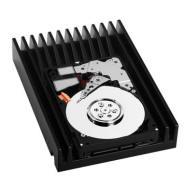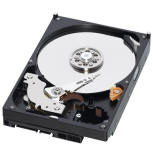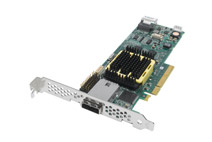|
E-Newsletter - July 2008
Contents:
| Building Affordable Enterprise Storage
Arrays
When it comes to storage, a lot of people think big and a lot
of people think small, but not so many people consider the
benefits of a happy medium.
In the enterprise world, tape libraries and racks of storage
servers are the norm in data protection. This is great
technology, but beyond the price reach of most SMB buyers. Small
storage in the business world can take many forms---perhaps an
external hard drive for backup on each client or a little RAID 5
built into the communal server. Although not the only
consideration, pricing becomes a key factor, and many small
business storage solutions proceed straight to the lowest common
denominator, even if it is consumer-grade hardware.
Yes, there are happy mediums. The object is to get
enterprise-class data protection at small business-level prices.
Those aren't incompatible objectives. All you need is a few
wisely chosen parts.
|
|

Western Digital VelociRaptor |
| The Drives
Western Digital is a wildly popular brand among consumers,
but the company has also spent years building up its enterprise
product line. Today, when you say "enterprise drives," most
people think of Serial Attached SCSI (SAS), and these remain the
highest performance drives available today. However, the
performance of SAS is primarily needed in storage systems aimed
at large-volume transactional applications, such as major
e-business servers and financial institutions.
The bulk of the enterprise drive market falls in nearline
applications, where important data is held for the intermediate-
to long-term so that it's within immediate reach if needed---as
opposed to archived storage, in which data is kept safe for the
long-term, but isn't available for real-time retrieval. SATA
technology delivers more than adequate performance for nearline
work provided that drive reliability is up to enterprise
standards. The industry generally accepts a 1.2 million-hour
mean-time between failure (MTBF) rating as being
enterprise-class. In contrast, consumer drives usually feature
MTBF ratings of 750,000 hours or less. |
|

Western Digital RE2 |
|
The workhorse of Western
Digital's enterprise family is the RE2, featuring a 1.2
million-hour MTBF, 7200 RPM spin rate, 3Gb/s SATA
interface, and capacities from 160GB to 750GB. Since
businesses often install many drives into a server or
JBOD enclosure, WD implements Rotary Acceleration Feed
Forward (RAFF) to dampen the vibration that, multiplied
by several drives running in tandem, can shake an
enclosure so much that data errors result. Also, note a
WD-pioneered feature called RAID-specific, time-limited
error recovery (TLER). Desktop drives are built to pause
and recover data in case of failure, a process that can
take so long (even minutes) that a RAID controller will
drop the drive from the array. The RE2 builds in a
seven-second time-out for in-drive error recovery. At
that point, the RAID controller is allowed to take over
recovery and in so doing avoids the drive being dropped
from the array. For those who want all of the RE's
benefits plus capacities up to 1TB and power-saving
features able to drop consumption by 4W to 5W versus
competing drives, check out the new RE2-GP models.
|
As we said,
enterprise SATA delivers strong performance for nearline
apps, but some customers still need to lean on speed yet
lack the funds for a full-blown SAS deployment. For
these situations, Western Digital now has the 300GB
VelociRaptor. This drive shrinks the platter size from
3.5-inch down to 2.5-inch in order to boost the spin
rate up to 10,000 RPM and so deliver significantly
faster throughput speeds. Faster platters can mean more
heat, which is why the VelociRaptor sports a mounting
frame with integrated heatsink fins. The drive features
a 1.4 million-hour MTBF and, like its RE cousins,
carries a five-year warranty.
|
| The Controller
Few people would argue against businesses needing the
performance benefits and/or data protection of RAID technology,
but a lot of people fail to account for the negative performance
impact of running a RAID in software, as with the "free" RAID
controller now built into most motherboard southbridge chips. In
fact, the computation demands of a RAID 6, which offers double
parity protection in case a second drive fails while a first is
being rebuilt, are so heavy that no chipsets today even offer
the feature.
|
|
Businesses need add-in controllers with integrated,
hardware-based acceleration to drive the storage subsystems on
which their operations depend. This means controllers need the
latest storage processors for maximum RAID performance combined
with a broad selection of supported RAID types, plenty of port
expansion room as drive counts grow over time, and storage
management software that makes the attached RAID(s) easy to set
up and maintain. Additionally, keep in mind that not only are
SAS and SATA plug-compatible at the controller level, but
SAS/SATA cards are now practically at price parity with
SATA-only controllers, making the combined controller option a
no-brainer. Should the customer ever need to migrate up into SAS
drives, the controller will be ready.
|
|

Adaptec RAID Controller 5445 |
|
One of our favorite recommendations in this field is
long-time storage card heavyweight Adaptec, and perhaps our
favorite starter model in Adaptec's lineup is the RAID 5445.
This low-profile unit can fit into thin form factor rackmount
servers, as well as conventional tower/pedestal systems. The
four-port internal connector tackles up to four SAS/SATA drives
while an external four-port connector can tie in a JBOD
enclosure in case the customer's storage needs mushroom. Like
all models in Adaptec's Series 5, the 5445 boasts a 1.2 GHz
RAID-on-Chip processor and the ability to support multiple RAID
volumes.
For example, a client might want a high-performance RAID 5
inside the storage server using VelociRaptor drives and an
external RAID 6 in a JBOD using half a dozen lower-cost RE2
drives. This sort of "tiered storage" approach can maximize a
business's storage investment, letting admins put dollars into
the features and specific configuration that best addresses
their companies' needs. Note that Adaptec Series 5 cards span
from the internal four-port 5405 up to the 28-port
internal/external 52445.
|
|
| The Solution
By combining the right drives with the right controllers,
your SMB customers can get far more performance and security
than they bargained for, and the solution can be tailored for
practically any physical environment. Ask your Tech Data rep for
more information about the best component options to solve your
clients' present and future storage demands.
|
top
Finding a Sure Thing
|
We all crave surety, but it sure is hard to
find. Businesses in particular need surety. Computer systems
must be predictable, dependable, and long-lasting. Anything that
disrupts workflow, from sporadic software incompatibilities to
outright hardware failure, can cost a business from hundreds to
millions of dollars in lost orders, confidential data, and
productivity. So in life there may be no sure bets, but there is
a way to provide your business clients with surefire system
configurations: the Intel Enabled Server Acceleration Alliance (ESAA).
|
|
The ESAA program is a cooperative effort
between Intel and ISVs that aims to provide reseller members
with highly tested, validated server solutions. In essence, you
know the hardware works and you know that software package has
been validated by the ISV on that hardware. When the
configuration passes, the ISV will create a "recipe" for it
illustrating the setup and deployment process. Intel currently
lists server configurations spread across 12 broad solution
categories, featuring vendors such a Citrix, EMC, Level
Platforms, NetApp, Oracle, Red Hat, Symantec and VMware. |
|
 |
|
To illustrate what the ESAA program can mean
to resellers, we thought casting a spotlight on VMware might be
timely. After all, while SMBs are still in the early stages of
adopting virtualization, industry-wide interest is high, and
it's a safe bet that virtualized server sales will be on the
rise going forward. If you're going to be in this space, getting
VMware-certified is an important asset, but doing so takes time
and expense. Until that hurtle is passed, perhaps having an
Intel-certified ESAA solution, based around VMware, is the
reputable endorsement needed to lock in customer confidence in
your solution.
|
|
The Recipe
VMware Infrastructure is a suite of
virtualization products designed to virtualize servers, storage
and networks. The current version is Infrastructure 3, with the
key management and reliability component, ESX Server, now in
version 3.5. Nobody doubts that VMware is the world's top name
and authority in virtualization, but solution providers still
have to pay close attention to configuration details. For
instance, Infrastructure 3 carries a maximum guest system RAM
configuration of 64GB and maximum guest CPUs of four. Just
because a recipe is bulletproof doesn't mean it can do
everything, and it's important to keep an eye on the maximum
serving size, so to speak, and similar constraints. This is
another area in which adhering to Intel's recipes can help
resellers. |
 |
|
For this particular recipe, Intel lists the
following: server board (Intel S5000PAL), 1U or 2U chassis
(Intel SR1500 or SR2500) along with their respective backplanes,
at least 4GB of memory, two Xeon processors, at least one SAS
3.5-inch hard drive, Intel's RAID activation key and Mini DIMM,
at least one Intel PRO/1000 Ethernet controller, and at least
one Broadcom 5700 series Ethernet controller. Performance
enthusiasts might question the RAID SKUs, observing that they're
meant to enable software-based RAID via the S500PAL. A
higher-performance alternative might have been one of Intel's
own RAID add-in controllers, but this would have added another
layer of driver complexity without perhaps adding any tangible
benefit to the entire solution. In the end, this is the
configuration that Intel guarantees to work, so add in VMware
Infrastructure and ESX Server and get going. |
|
These recipes are at times a refreshing
change. For example, right at the beginning of the recipe during
the installation notes, Intel states: ESX Server
3.0/3.0.1/3.0.2/3.5 is NOT supported by Intel I/OAT at this
time. DISABLE the "Intel I/OAT" in the BIOS before installing
ESX Server 3.0/3.0.1/3.0.2/3.5 to avoid the red error message
"0:00:00:13:155 CPU0: 1024) PCI:1650: Failed for 000:08.0". We
think the world of I/OAT, and Intel has taken no small pains to
promote the network technology, so seeing such a recommendation
made so prominently and specifically strikes us as a testament
to Intel's dedication to quality above all else.
In fact, Intel's attention to detail
throughout the recipe is exhaustive. If you've ever been delayed
or confounded with having to muddle through obtaining licenses,
the ESAA recipe tells you how to do it in seven steps. Intel
walks you through installing ESX Server in the text-based and
GUI-based modes, then through everything from partitioning to
network configuration to client setup to script generation.
|
| The Big Picture
"ESAA recipes can be an important tool for
the channel as they provide a path for resellers/integrators to
use validated configurations," says North American Channel
Products Marketing Manager Todd Garrigues. "The recipes can ease
resellers' time to market and help lower their cost investment
on a new solution. You don't have to burn a lot of extra time on
testing, tweaking, trial and error. When you follow the recipe,
all the work has already been done for you."
In effect, ESAA recipes are a triple-barreled
benefit for your sales efforts. Not only do they confer
validation from a world-class authority (Intel), but they also
lower support complications and accelerate time to delivery.
From here, the only thing left to do is make sure you pick a
distributor with the training and product selection to enable
you to put these recipes into action. Thanks to its extensive
relationship with Intel, Tech Data should be on your very short
list of sources best qualified for the job.
|
top
Last updated:
10/02/2008 01:08 PM
Enjoy your visit!
Support services and website data presented herein and on all subordinate sites are based upon technical information
provided by the manufacturers of the relevant products sold by Tech Data.
Tech Data believes this information to be accurate; however, Tech Data makes no representations or warranties with respect to the performance of the
support services and information, and any and all warranties, whether oral or written, expressed or implied, are hereby expressly disclaimed by Tech Data,
including, but not limited to, warranties of merchantability and fitness for a particular purpose.
|
Product Support |

|
HOME |
| |
|